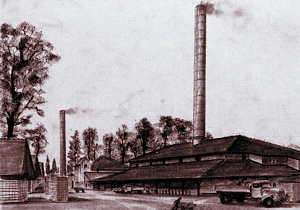 In the year 1905 ...
In the year 1905 ...
the factory was established by Matthias Küsters from Goch, a town close to Kleve. Here in Kellen (= Rom. "Celina") emerged first of all a so-called “Feldbrandofen”, or “open fired kiln”. The clay was prepared laboriously with a spade at that time, and formed in wooden boxes then dried for months in the open air before the dried mouldings could be stacked up for firing. From Lippischen, specialist brickmakers came once annually to lay the bricks around the fire. When the fired bricks were ready, the brickmaker had to come out for an entire year.
Beginning of the '30's ...
A ring oven (ultra-modern for that time) was installed, and made from incombustible material. The raw materials were brought in with hand-carts into the oven and were set into the firing channel. Coal was added by hand through so-called “stir-up holes” and over the fire, through into the firing channel. After the death of the firm’s founder in 1935, his daughter Helma Küsters took over management of the business, which she expanded with the help of an efficient colleague through the confusion and difficulty of the war and post-war years, to become a successful and modern brick factory.
Beginning of the '60's ...
an artificial drying chamber and a large clay store had already emerged. The business developed carefully to a modern industrial company.
In the 70, 80 and '90's ...
modernisation continued further. Among other things, a modern tunnel kiln was introduced, which is fully computer controlled and can achieve closely set temperatures. Our drying chambers were also expanded and modernised: Here one finds the most modern electonics-based controls and technology remains at the heart of development.
As the most committed of all company personnel, Mrs Helma Küsters died at the age of 92 years, which gave responsibility for running the company to its long-time manager, Norbert Hegholtz, so that the work continues successfully since then in time-honoured tradition.







